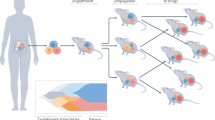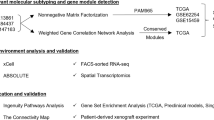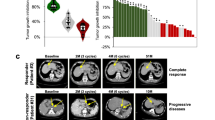Abstract
Gastric cancer (GC) is the third leading cause of cancer-related mortality and the fourth most prevalent malignancy globally. The high prevalence and mortality rates of GC are attributed to various factors, including drug resistance, local recurrence, and distant metastases. There is an urgent need to identify novel therapeutic targets for GC. Patient-derived xenografts (PDX) model offers unique advantages in maintaining the molecular heterogeneity and tumor microenvironment of primary tumors, offering significant advantages for the screening of personalized therapeutic targets. In this study, we established GC PDX models with metastatic potential through orthotopic transplantation and investigated the different gene expressions between primary and metastatic tumors using PCR-array analysis. We found that the metastatic tumors displayed elevated levels of FXYD domain-containing ion transport regulator 5 (FXYD5) compared to the primary tumors. Additionally, reducing FXYD5 expression was found to inhibit the invasion, metastasis, and proliferation of GC cells. Silencing FXYD5 also reversed the resistance of GC cells to doxorubicin and vincristine by modulating the epithelial–mesenchymal transition (EMT) process and the expression of multidrug resistance protein 2. This study indicates that FXYD5 is involved in GC progression and regulates chemotherapy resistance, suggesting its potential as a novel therapeutic target for the clinical treatment of GC.
This is a preview of subscription content, access via your institution
Access options
Subscribe to this journal
Receive 12 print issues and online access
$259.00 per year
only $21.58 per issue
Buy this article
- Purchase on SpringerLink
- Instant access to full article PDF
Prices may be subject to local taxes which are calculated during checkout





Similar content being viewed by others
Data availability
The data are available from the corresponding author upon reasonable request.
References
Elmira T, Haying S, Nimrod DY, Yi W, Laura DA. The O-glycosylated ectodomain of FXYD5 impairs adhesion by disrupting cell–cell trans-dimerization of Na,K-ATPase β1 subunits. J Cell Sci. 2016;129:2394–406. https://doi.org/10.1242/jcs.186148
José BM, Marina R, Lara L, Cristian PM, María LM, María F, et al. FXYD5/Dysadherin, a biomarker of endometrial cancer myometrial invasion and aggressiveness: its relationship with TGF-β1 and NF-κB pathways. Front Oncol. 2019;9:1306. https://doi.org/10.3389/fonc.2019.01306
Juurikka K, Dufour A, Pehkonen K, Mainoli B, Campioni Rodrigues P, Solis N, et al. MMP8 increases tongue carcinoma cell–cell adhesion and diminishes migration via cleavage of anti-adhesive FXYD5. Oncogenesis. 2021;10:44. https://doi.org/10.1038/s41389-021-00334-x
Yin S, Wang P, Yang L, Liu Y, Wang Y, Liu MM, et al. Wip1 suppresses ovarian cancer metastasis through the ATM/AKT/snail mediated signaling. Oncotarget. 2016;7:29359–70. https://doi.org/10.18632/oncotarget.8833
Okada S, Vaeteewoottacharn K, Kariya R. Application of highly immunocompromised mice for the establishment of patient-derived xenograft (PDX) models. Cells. 2019;8:889. https://doi.org/10.3390/cells8080889
Gotliv IL. FXYD5: Na(+)/K(+)-ATPase regulator in health and disease. Front Cell Dev Biol. 2016;4:26. https://doi.org/10.3389/fcell.2016.00026
Raman P, Purwin T, Pestell R, Tozeren A. FXYD5 is a marker for poor prognosis and a potential driver for metastasis in ovarian carcinomas. Cancer Inform. 2015;14:113–9. https://doi.org/10.4137/CIN.S30565
Renata AT, Angela G, Laura A, Eliana B, Paola T, Chiara R, et al. FXYD5 (Dysadherin) upregulation predicts shorter survival and reveals platinum resistance in high-grade serous ovarian cancer patients. Br J Cancer. 2019;121:584–92. https://doi.org/10.1038/s41416-019-0553-z
Qiu ZQ, Wang X, Ji XW, Jiang FJ, Han XY, Zhang WL, et al. The clinical relevance of epithelial-mesenchymal transition and its correlations with tumorigenic immune infiltrates in hepatocellular carcinoma. Immunology. 2022. https://doi.org/10.1111/imm.13465
Naharro AV, Taule JB, Floristán A, Yuste L, Oltra SS, Vinyals A, et al. Loxl3 promotes melanoma progression and dissemination influencing cell plasticity and survival. Cancers (Basel) 2022;14. https://doi.org/10.3390/cancers14051200.
Huang DS, Duan HY, Huang H, Tong XM, Han Y, Ru GQ, et al. Cisplatin resistance in gastric cancer cells is associated with HER2 upregulation-induced epithelial–mesenchymal transition. Sci Rep. 2016;6:20502. https://doi.org/10.1038/srep20502
Du B, Shim J. Targeting epithelial–mesenchymal transition (EMT) to overcome drug resistance in cancer. Molecules. 2016;21:965. https://doi.org/10.3390/molecules21070965
Kim HP, Han SW, Song SH, Jeong EG, Lee MY, Hwang D, et al. Testican-1- mediated epithelial–mesenchymal transition signaling confers acquired resistance to lapatinib in HER2-positive gastric cancer. Oncogene. 2014;33:3334–41. https://doi.org/10.1038/onc.2013.285
Yutaka S, Seiji Y, Yosuke H, Tetsuo I, Jun-ichiro K, Toshiya S, et al. Clinical significance of dysadherin expression in gastric cancer patients. Clin Cancer Res. 2004;10:2818–23. https://doi.org/10.1158/1078-0432.ccr-0633-03
Yang B, Dong LL, Jun L, Rui FC, Hai LY, He FS, et al. A FXYD5/TGF‑β/SMAD positive feedback loop drives epithelial‑to‑mesenchymal transition and promotes tumor growth and metastasis in ovarian cancer. Int J Oncol. 2020;56:301–14. https://doi.org/10.3892/ijo.2019.4911
Aristeidis BE, Neng ZY, Bruno S, Adam K, Zhao YY, Liu YS, et al. A reversible metabolic stress-sensitive regulation of CRMP2A orchestrates EMT/stemness and increases metastatic potential in cancer. Cell Rep 2022;38:110511. https://doi.org/10.1016/j.celrep.2022.110511.
Yang Y, Wei RP, Feng LX, Sun XY, Zhang CF, Du XJ, et al. PPP1R26 drives hepatocellular carcinoma progression by controlling glycolysis and epithelial–mesenchymal transition. J Exp Clin Cancer Res. 2022;41:101. https://doi.org/10.1186/s13046-022-02302-8
Maria R, Iduna F, Annika WG, Christine S, Johannes M, Giannino P, et al. Patient-derived xenograft (PDX) models of colorectal carcinoma (CRC) as a platform for chemosensitivity and biomarker analysis in personalized medicine. Neoplasia. 2021;23:21–35. https://doi.org/10.1016/j.neo.2020.11.005
Park JR, Kim RJ, Lee YK, Kim SR, Roh KJ, Oh SH, et al. Dysadherin can enhance tumorigenesis by conferring properties of stem-like cells to hepatocellular carcinoma cells. J Hepatol. 2011;54:122–31. https://doi.org/10.1016/j.jhep.2010.06.026
Indrani D, Dylan DC, James WP, Anais M, Julia S, Darren JD, et al. ADAM protease inhibition overcomes resistance of breast cancer stem-like cells to γδ T cell immunotherapy. Cancer Lett. 2021;496:156–68. https://doi.org/10.1016/j.canlet.2020.10.013
Yang ZY, Zhao N, Cui J, Wu HS, Xiong JX, Peng T. Exosomes derived from cancer stem cells of gemcitabine-resistant pancreatic cancer cells enhance drug resistance by delivering miR-210. Cell Oncol (Dordr). 2020;43:123–36. https://doi.org/10.1007/s13402-019-00476-6
Anuka S, Harmandeep K, Renaissa D, Radhika S, Arnab P, Shalmoli B. Knockdown of E-cadherin induces cancer stem-cell-like phenotype and drug resistance in cervical cancer cells. Biochem Cell Biol. 2021;99:587–95. https://doi.org/10.1139/bcb-2020-0592
Ge Y, Weygant N, Qu DF, May R, Berry WL, Yao JN, et al. Alternative splice variants of DCLK1 mark cancer stem cells, promote self-renewal and drug-resistance, and can be targeted to inhibit tumorigenesis in kidney cancer. Int J Cancer. 2018;143:1162–75. https://doi.org/10.1002/ijc.31400
Lee YK, Lee SY, Park JR, Kim RJ, Kim SR, Roh KJ, et al. Dysadherin expression promotes the motility and survival of human breast cancer cells by AKT activation. Cancer Sci. 2012;103:1280–9. https://doi.org/10.1111/j.1349-7006.2012.02302.x
Irina LG, Kuntal D, Yuri K, Vecheslav K, Carol A, Haim G. FXYD5 (dysadherin) may mediate metastatic progression through regulation of the β-Na-K-ATPase subunit in the 4T1 mouse breast cancer model. Am J Physiol Cell Physiol. 2017;313:C108–C117. https://doi.org/10.1152/ajpcell.00206.2016
Liu YK, Jia YJ, Liu SH, Shi HJ, Ma J. Low expression of FXYD5 reverses the cisplatin resistance of epithelial ovarian cancer cells. Histol Histopathol. 2021;36:535–45.
Tan XP, Xiong BH, Zhang YX, Wang SL, Zuo Q, Li J. FXYD5 promotes sorafenib resistance through the Akt/mTOR signaling pathway in hepatocellular carcinoma. Eur J Pharmacol. 2022;931:175186.
Ding L, Li J. FXYD domain containing ion transport regulator 5 (FXYD5) silencing promotes cell viability and alleviates inflammatory response in cerulein-induced AR42J cells by blocking JAK2/STAT3 signaling pathway. Bioengineered. 2022;13:2639–47.
Acknowledgements
This work was funded by the National Natural Science Foundation of China (32270566 and 32070532), Laboratory Animal Foundation Program (No. SYDW_KY 2021-14), and Shaanxi Province Innovation Capability Support Plan (2022PT-38).
Author information
Authors and Affiliations
Contributions
Conceptualization: YM; validation: YM and YH; methodology: YM, YH, and HM; formal analysis: QA and CZ; investigation: CG and YZ; writing—original draft preparation: CS and XG; visualization: CS and XG; funding acquisition: CS All authors have read and agreed to the published version of the manuscript.
Corresponding authors
Ethics declarations
Competing interests
The authors declare no competing interests.
Ethical approval
All patients gave written informed consent and all study protocols were performed in accordance with the approved guidelines by Xijing Hospital Clinical Research Ethics Committee (KY20173028-1). All animal experiment was approved by the Experimental Animal Welfare and Ethics Committee of AFMU (Approval No. 2018017). All methods were performed in accordance with the relevant guidelines and regulations of AFMU.
Additional information
Publisher’s note Springer Nature remains neutral with regard to jurisdictional claims in published maps and institutional affiliations.
Supplementary information
Rights and permissions
Springer Nature or its licensor (e.g. a society or other partner) holds exclusive rights to this article under a publishing agreement with the author(s) or other rightsholder(s); author self-archiving of the accepted manuscript version of this article is solely governed by the terms of such publishing agreement and applicable law.
About this article
Cite this article
Mao, Y., Hu, Y., Meng, H. et al. FXYD5 regulates gastric cancer cell metastasis and drug resistance by EMT modulation. Cancer Gene Ther 32, 318–326 (2025). https://doi.org/10.1038/s41417-025-00878-9
Received:
Revised:
Accepted:
Published:
Issue date:
DOI: https://doi.org/10.1038/s41417-025-00878-9
This article is cited by
-
FKH domain-mediated nuclear FOXP3 suppresses gastric cancer malignancy via c-MYC/CDKN1A regulation, EMT inhibition, and PI3K/AKT signaling modulation
Molecular and Cellular Biochemistry (2025)



